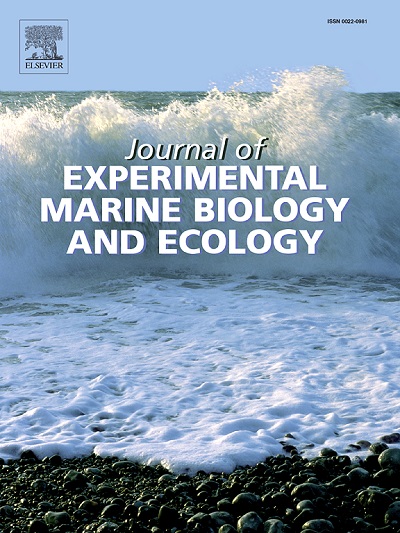Overwintering performance of three juvenile temperate estuarine fishes
IF 1.8
3区 生物学
Q3 ECOLOGY
Journal of Experimental Marine Biology and Ecology
Pub Date : 2025-02-14
DOI:10.1016/j.jembe.2025.152087
引用次数: 0
Abstract
Estuaries, rich in biodiversity and economically valuable fish species, are increasingly threatened by climate change-induced factors that challenge fish resilience and survival. This study compared the juvenile performance of three estuarine fish species (eastern fortescue, Centropogon australis, common silverbiddy, Gerres subfasciatus, and eastern striped trumpeter, Pelates sexlineatus) at two water temperatures reflecting two scenarios: current Sydney winters (16 °C) and future winters under climate change (20 °C). The fishes' total range of acclimation duration was 16 days at each temperature level, and the experiment included two food levels (low and high), along with two different treatments that accounted for the orders of temperature exposure (20 °C then 16 °C, vs 16 °C then 20 °C). We used a broad range of behavioural and physiological metrics such as growth (change in mass and length), metabolic rate, bite rate, burst speed, boldness, shelter and predator escape response. Overall, as expected from metabolic theory, fish performance was generally greater at higher (future) winter temperatures than at lower (current) winter temperatures, with growth rates, change in total length, bite rate and aerobic scope higher at 20 °C than 16 °C for all species. G. subfasciatus and P. sexlineatus exhibited increased escape responses at 20 °C, with P. sexlineatus also showing greater boldness. Boldness was positively associated with bite rates in P. sexlineatus, potentially indicating foraging advantages under future warming for this species. The order of temperature treatment affected boldness for G. subfasciatus and growth, bite rate and burst speed for P. sexlineatus. Overall, and surprisingly, performance metrics were largely unrelated.
Contrary to expectations, food had no effect on fish performance either directly or interacting with temperature. Our findings suggest this study was conducted below the species' thermal optima, and future climate change may therefore favour temperate juvenile estuarine fishes at winter temperatures, with potential benefits differing among these species.
三种温带河口幼鱼的越冬性能
河口拥有丰富的生物多样性和具有经济价值的鱼类品种,但它们日益受到气候变化引起的因素的威胁,这些因素挑战了鱼类的恢复力和生存能力。本研究比较了三种河口鱼类(东部fortescue, Centropogon australis, common silverbiddy, Gerres subfasciatus和东部条纹号手,Pelates sexlineatus)在两种水温下的幼鱼表现,这两种水温反映了两种情景:当前悉尼冬季(16°C)和未来气候变化冬季(20°C)。在每个温度水平下,鱼的总驯化时间范围为16天,实验包括两个食物水平(低和高),以及两种不同的处理,这些处理占温度暴露的顺序(20°C然后16°C, 16°C然后20°C)。我们使用了广泛的行为和生理指标,如生长(质量和长度的变化)、代谢率、咬伤率、爆发速度、大胆度、庇护所和捕食者逃离反应。总体而言,正如代谢理论所预期的那样,鱼类在较高(未来)冬季温度下的表现通常比较低(当前)冬季温度下更好,所有物种在20°C时的生长速度、总长度变化、咬伤率和需氧范围都高于16°C。在20°C条件下,筋膜下松鸡和雌雄松鸡的逃跑反应增强,雌雄松鸡也表现出更大的胆度。雌雄鳗的大胆度与咬伤率呈正相关,这可能表明该物种在未来变暖条件下的觅食优势。温度处理顺序影响了筋膜下松鸡的胆度,影响了雌雄松鸡的生长、咬伤率和爆发速度。总的来说,令人惊讶的是,性能指标在很大程度上是不相关的。与预期相反,食物对鱼的表现没有直接影响,也没有与温度相互作用。我们的研究结果表明,这项研究是在物种的最佳温度下进行的,未来的气候变化可能因此有利于温带河口幼鱼在冬季的温度下,这些物种的潜在利益不同。
本文章由计算机程序翻译,如有差异,请以英文原文为准。
求助全文
约1分钟内获得全文
求助全文
来源期刊
CiteScore
4.30
自引率
0.00%
发文量
98
审稿时长
14 weeks
期刊介绍:
The Journal of Experimental Marine Biology and Ecology provides a forum for experimental ecological research on marine organisms in relation to their environment. Topic areas include studies that focus on biochemistry, physiology, behavior, genetics, and ecological theory. The main emphasis of the Journal lies in hypothesis driven experimental work, both from the laboratory and the field. Natural experiments or descriptive studies that elucidate fundamental ecological processes are welcome. Submissions should have a broad ecological framework beyond the specific study organism or geographic region.
Short communications that highlight emerging issues and exciting discoveries within five printed pages will receive a rapid turnaround. Papers describing important new analytical, computational, experimental and theoretical techniques and methods are encouraged and will be highlighted as Methodological Advances. We welcome proposals for Review Papers synthesizing a specific field within marine ecology. Finally, the journal aims to publish Special Issues at regular intervals synthesizing a particular field of marine science. All printed papers undergo a peer review process before being accepted and will receive a first decision within three months.

 求助内容:
求助内容: 应助结果提醒方式:
应助结果提醒方式:


